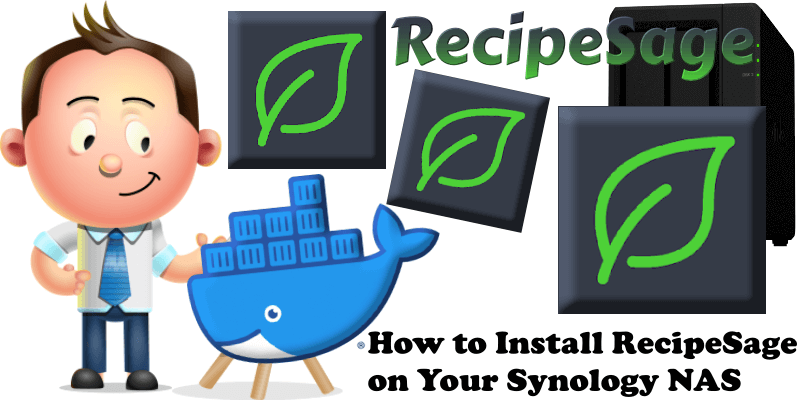
RecipeSage is an open source collaborative recipe keeper, meal planner and shopping list organizer. Share and collaborate on recipes, manage household shopping lists and meal planning, and import recipes from anywhere on the web instantly. In this step by step guide I will show you how to install RecipeSage on your Synology NAS with Docker & Portainer. Note: This container will not work in a NAS without AVX support.
STEP 1
Please Support My work by Making a Donation.
STEP 2
Install Portainer using my step by step guide. If you already have Portainer installed on your Synology NAS, skip this STEP. Attention: Make sure you have installed the latest Portainer version.
STEP 3
Make sure you have a synology.me Wildcard Certificate. Follow my guide to get a Wildcard Certificate. If you already have a synology.me Wildcard certificate, skip this STEP.
STEP 4
Go to Control Panel / Login Portal / Advanced Tab / click Reverse Proxy. Follow the instructions in the image below.
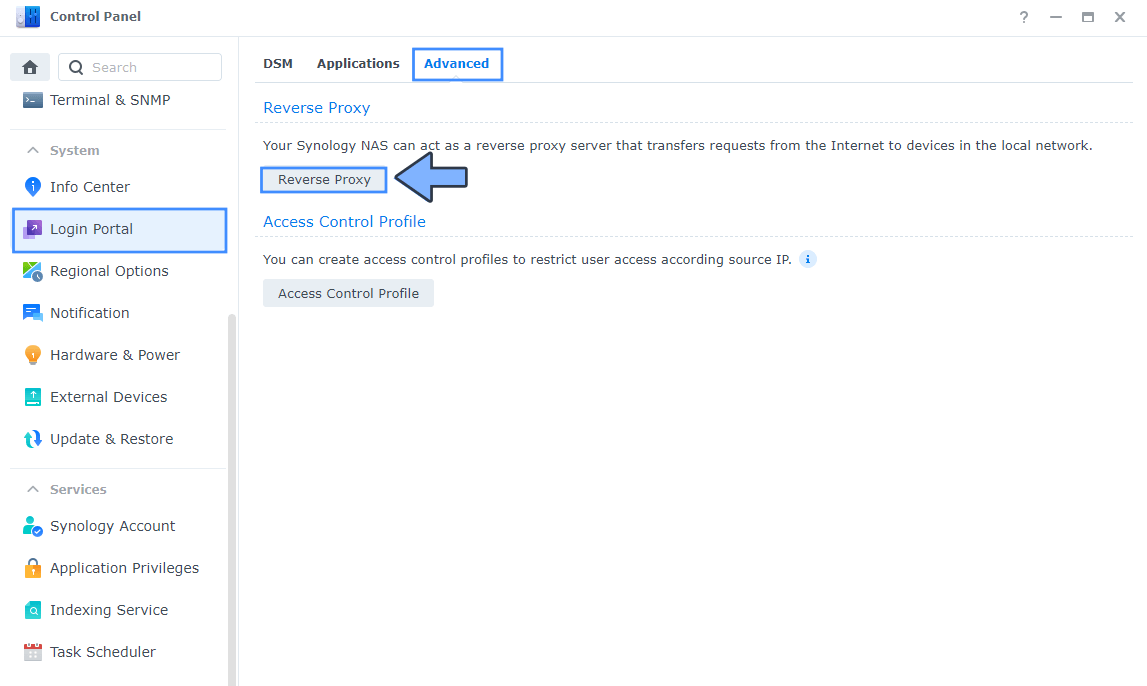
STEP 5
Now click the “Create” button. Follow the instructions in the image below.
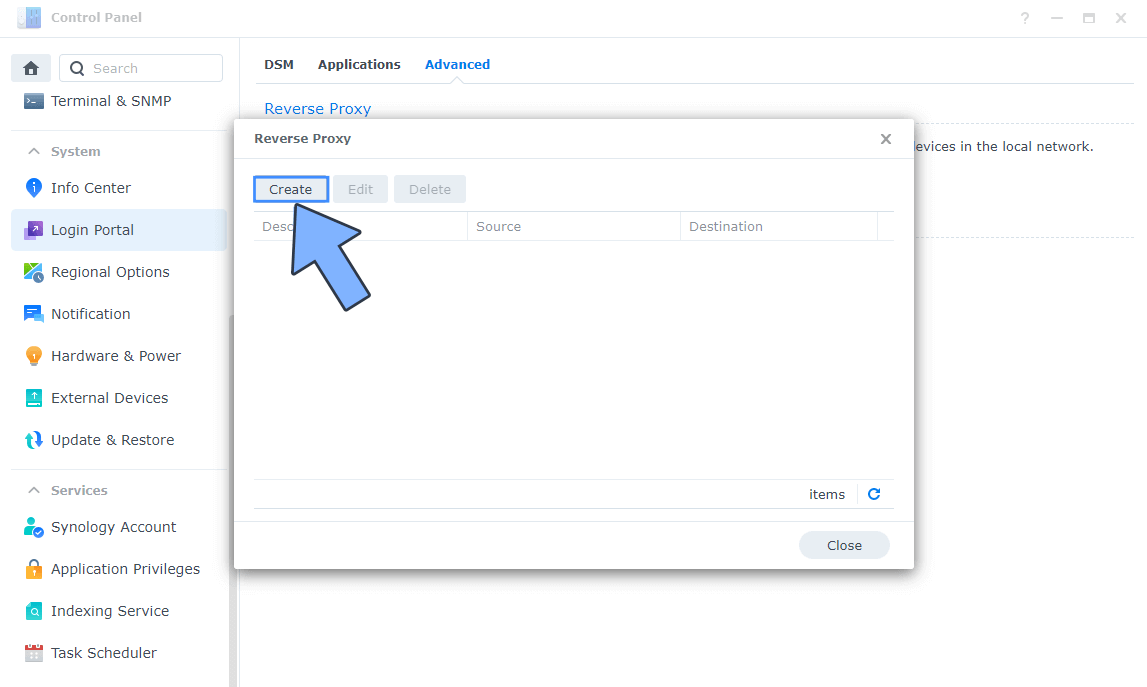
STEP 6
After you click the Create button, the window below will open. Follow the instructions in the image below.
On the General area, set the Reverse Proxy Name description: type in RecipeSage. After that, add the following instructions:
Source:
Protocol: HTTPS
Hostname: recipesage.yourname.synology.me
Port: 443
Check Enable HSTS
Destination:
Protocol: HTTP
Hostname: localhost
Port: 6914
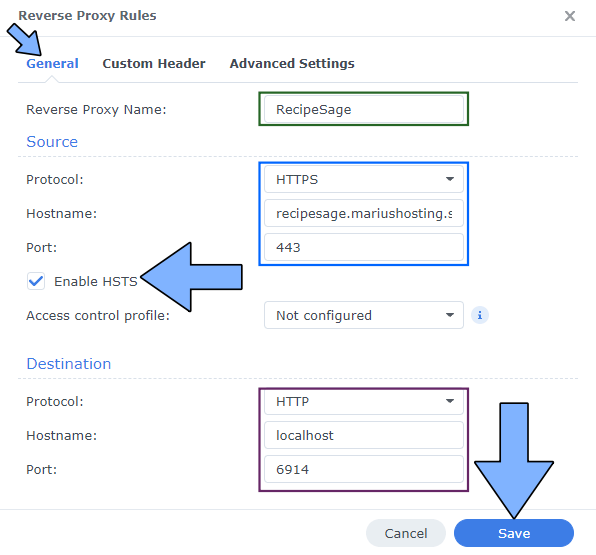
STEP 7
On the Reverse Proxy Rules click the Custom Header tab. Click Create and then, from the drop-down menu, click WebSocket. After you click on WebSocket, two Header Names and two Values will be automatically added. Click Save. Follow the instructions in the image below.

STEP 8
Go to Control Panel / Network / Connectivity tab/ Check Enable HTTP/2 then click Apply. Follow the instructions in the image below.
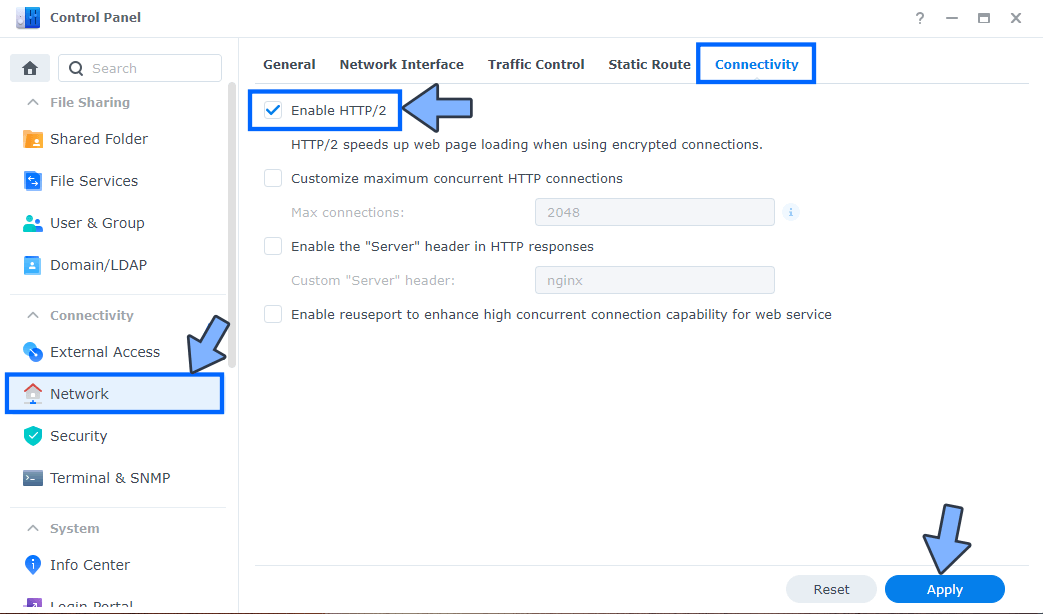
STEP 9
Go to Control Panel / Security / Advanced tab/ Check Enable HTTP Compression then click Apply. Follow the instructions in the image below.
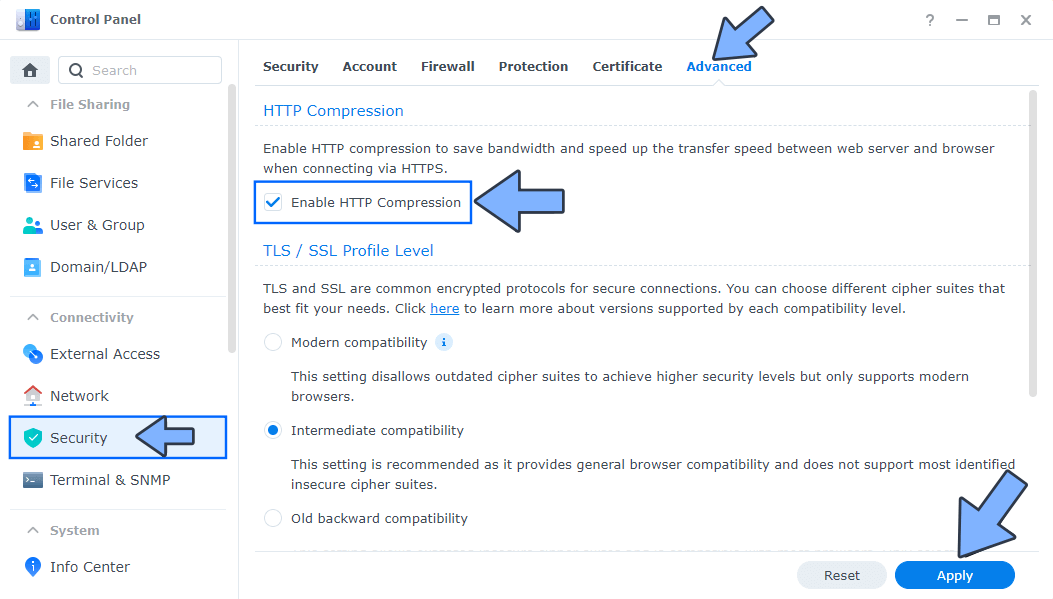
STEP 10
Go to File Station and open the docker folder. Inside the docker folder, create one new folder and name it recipesage. Follow the instructions in the image below.
Note: Be careful to enter only lowercase, not uppercase letters.
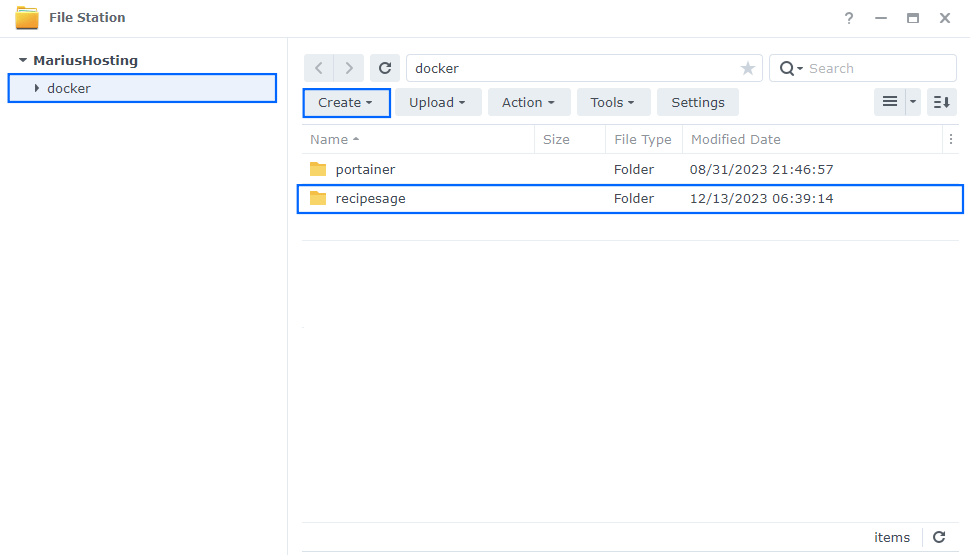
STEP 11
Now create three new folders inside the recipesage folder that you have previously created at STEP 10 and name them apimedia, db, typesense. Follow the instructions in the image below.
Note: Be careful to enter only lowercase, not uppercase letters.
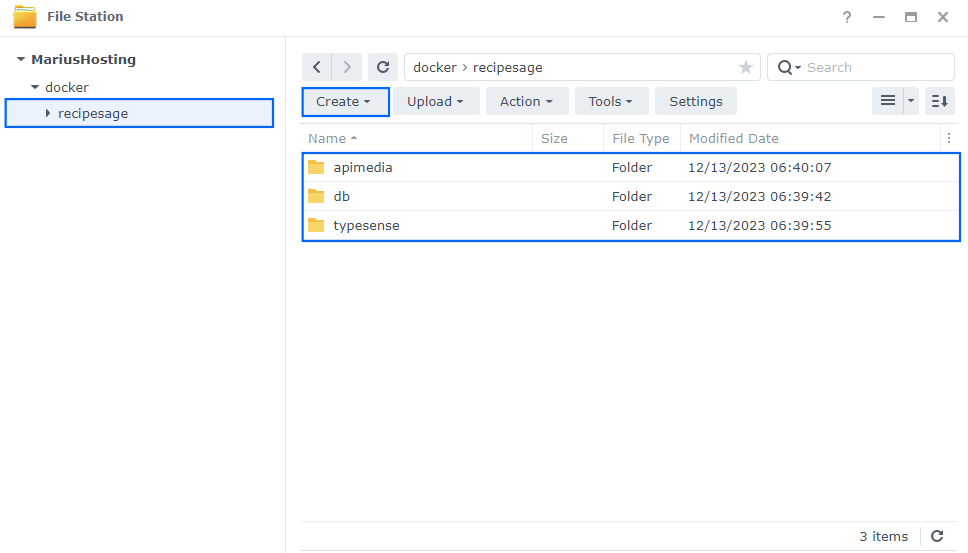
STEP 12
Download (click on the blue link below) then upload the proxy.conf file below in the recipesage folder that you have previously created at STEP 10. Follow the instructions in the image below. 🔒Note: Support my work to unlock the password. You can use this password to download any file on mariushosting forever!
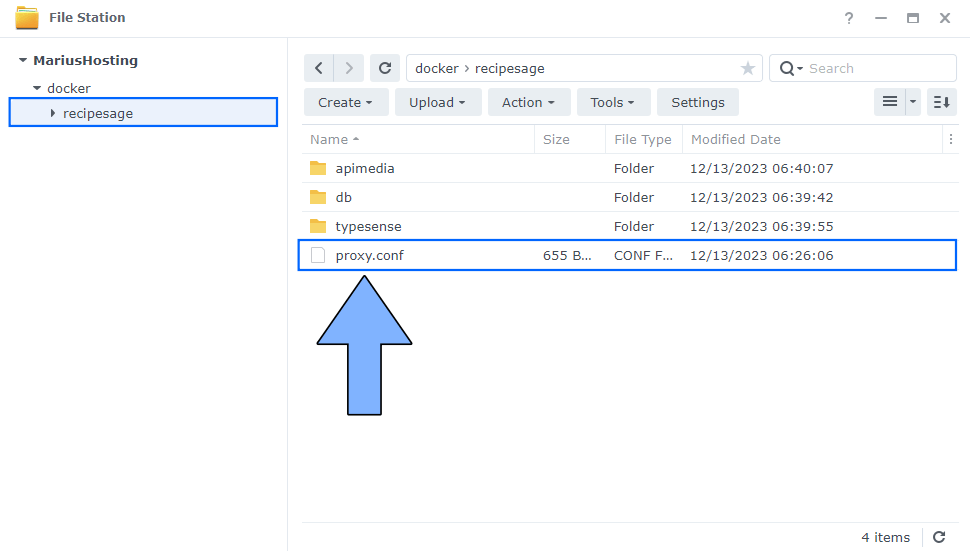
STEP 13
Log into Portainer using your username and password. On the left sidebar in Portainer, click on Stacks then + Add stack. Follow the instructions in the image below.
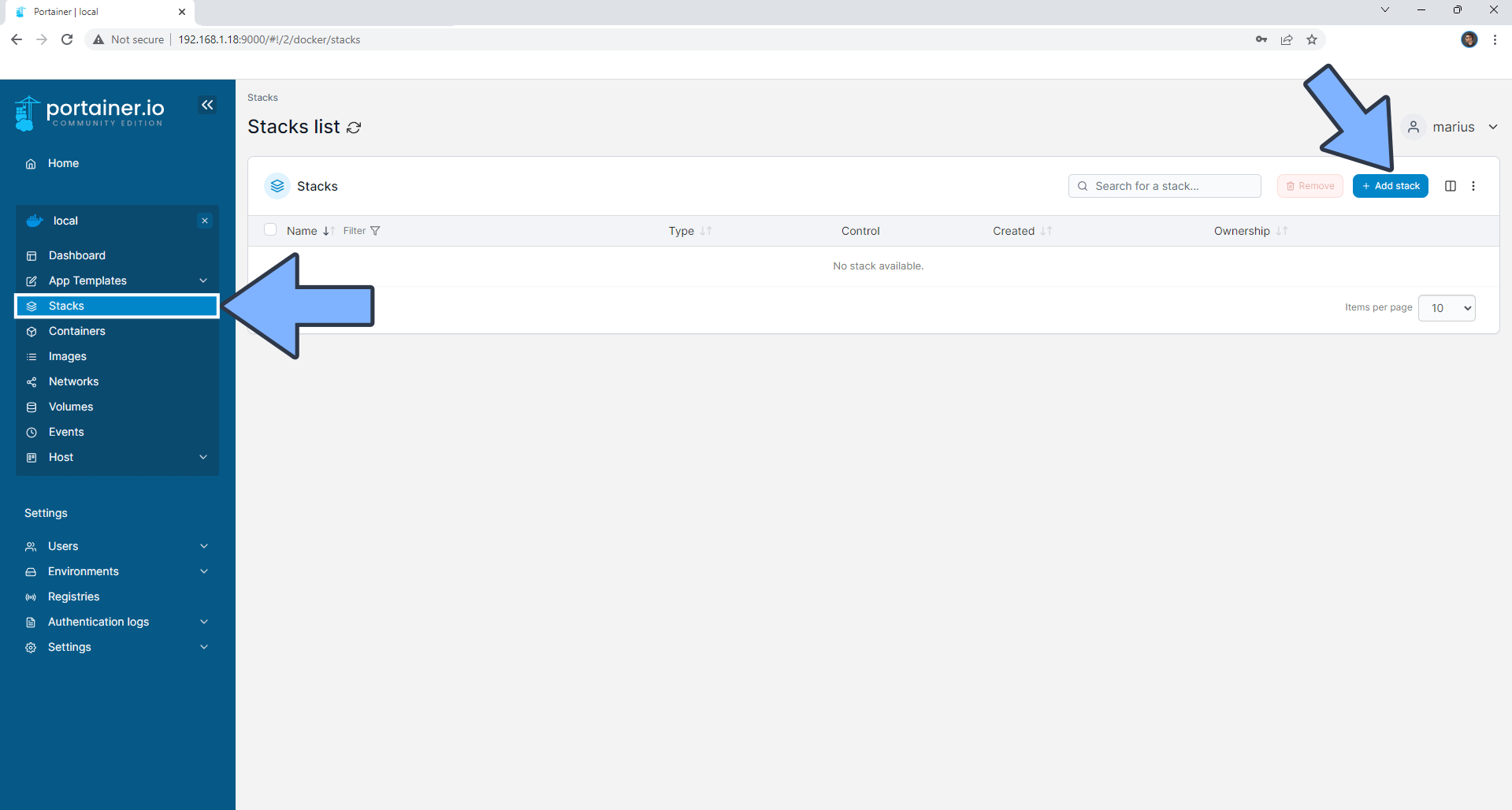
STEP 14
In the Name field type in recipesage. Follow the instructions in the image below.
services:
db:
image: postgres:16
container_name: RecipeSage-DB
hostname: recipesage-db
security_opt:
- no-new-privileges:true
healthcheck:
test: ["CMD", "pg_isready", "-q", "-d", "recipesage", "-U", "recipesageuser"]
timeout: 45s
interval: 10s
retries: 10
volumes:
- /volume1/docker/recipesage/db:/var/lib/postgresql/data:rw
environment:
POSTGRES_DB: recipesage
POSTGRES_USER: recipesageuser
POSTGRES_PASSWORD: recipesagepass
restart: on-failure:5
pushpin:
image: julianpoy/pushpin:2023-09-17
container_name: RecipeSage-PUSHPIN
hostname: pushpin
security_opt:
- no-new-privileges:true
environment:
target: api:3000
restart: on-failure:5
typesense:
image: typesense/typesense:0.25.1
command: "--data-dir /data --api-key=recipesage_selfhost --enable-cors"
container_name: RecipeSage-TYPESENSE
hostname: typesense
security_opt:
- no-new-privileges:true
read_only: true
user: 1026:100
volumes:
- /volume1/docker/recipesage/typesense:/data:rw
restart: on-failure:5
browserless:
image: ghcr.io/browserless/chromium:v2.24.3
container_name: RecipeSage-BROWSER
hostname: browserless
security_opt:
- no-new-privileges:true
user: 1026:100
environment:
MAX_CONCURRENT_SESSIONS: 3
MAX_QUEUE_LENGTH: 10
restart: on-failure:5
ingredient-instruction-classifier:
image: julianpoy/ingredient-instruction-classifier:1.4.9
container_name: RecipeSage-CLASSIFIER
hostname: ingredient-instruction-classifier
security_opt:
- no-new-privileges:true
read_only: true
user: 1026:100
environment:
SENTENCE_EMBEDDING_BATCH_SIZE: 200
PREDICTION_CONCURRENCY: 4
restart: on-failure:5
api:
image: julianpoy/recipesage-selfhost:api-latest
command: sh -c "npx prisma migrate deploy; npx nx seed prisma; npx ts-node --swc --project packages/backend/tsconfig.json packages/backend/src/bin/www"
container_name: RecipeSage-API
hostname: api
security_opt:
- no-new-privileges:true
volumes:
- /volume1/docker/recipesage/apimedia:/rs-media:rw
environment:
STORAGE_TYPE: filesystem
FILESYSTEM_STORAGE_PATH: /rs-media
NODE_ENV: selfhost
VERBOSE: false
VERSION: selfhost
POSTGRES_DB: recipesage
POSTGRES_USER: recipesageuser
POSTGRES_PASSWORD: recipesagepass
POSTGRES_PORT: 5432
POSTGRES_HOST: recipesage-db
POSTGRES_SSL: false
POSTGRES_LOGGING: false
DATABASE_URL: postgresql://recipesageuser:recipesagepass@recipesage-db:5432/recipesage
GCM_KEYPAIR:
SENTRY_DSN:
GRIP_URL: http://pushpin:5561/
GRIP_KEY: changeme
SEARCH_PROVIDER: typesense
TYPESENSE_NODES: '[{"host": "typesense", "port": 8108, "protocol": "http"}]'
TYPESENSE_API_KEY: recipesage_selfhost
STRIPE_SK:
STRIPE_WEBHOOK_SECRET:
BROWSERLESS_HOST: browserless
BROWSERLESS_PORT: 3000
INGREDIENT_INSTRUCTION_CLASSIFIER_URL: http://ingredient-instruction-classifier:3000/
restart: on-failure:5
depends_on:
db:
condition: service_healthy
pushpin:
condition: service_started
typesense:
condition: service_started
browserless:
condition: service_started
static:
image: julianpoy/recipesage-selfhost:static-latest
container_name: RecipeSage-STATIC
hostname: static
security_opt:
- no-new-privileges:true
environment:
API_BASE_OVERRIDE: null
restart: on-failure:5
proxy:
image: nginx:latest
container_name: RecipeSage-PROXY
hostname: proxy
security_opt:
- no-new-privileges:true
ports:
- 6914:80
volumes:
- /volume1/docker/recipesage/proxy.conf:/etc/nginx/conf.d/default.conf:ro
restart: on-failure:5
depends_on:
static:
condition: service_started
api:
condition: service_started
pushpin:
condition: service_started
Note: Before you paste the code above in the Web editor area below, change the value numbers for user with your own UID and GID values. (Follow my step by step guide on how to do this.) 1026 is my personal UID value and 100 is my personal GID value. You have to type in your own values.
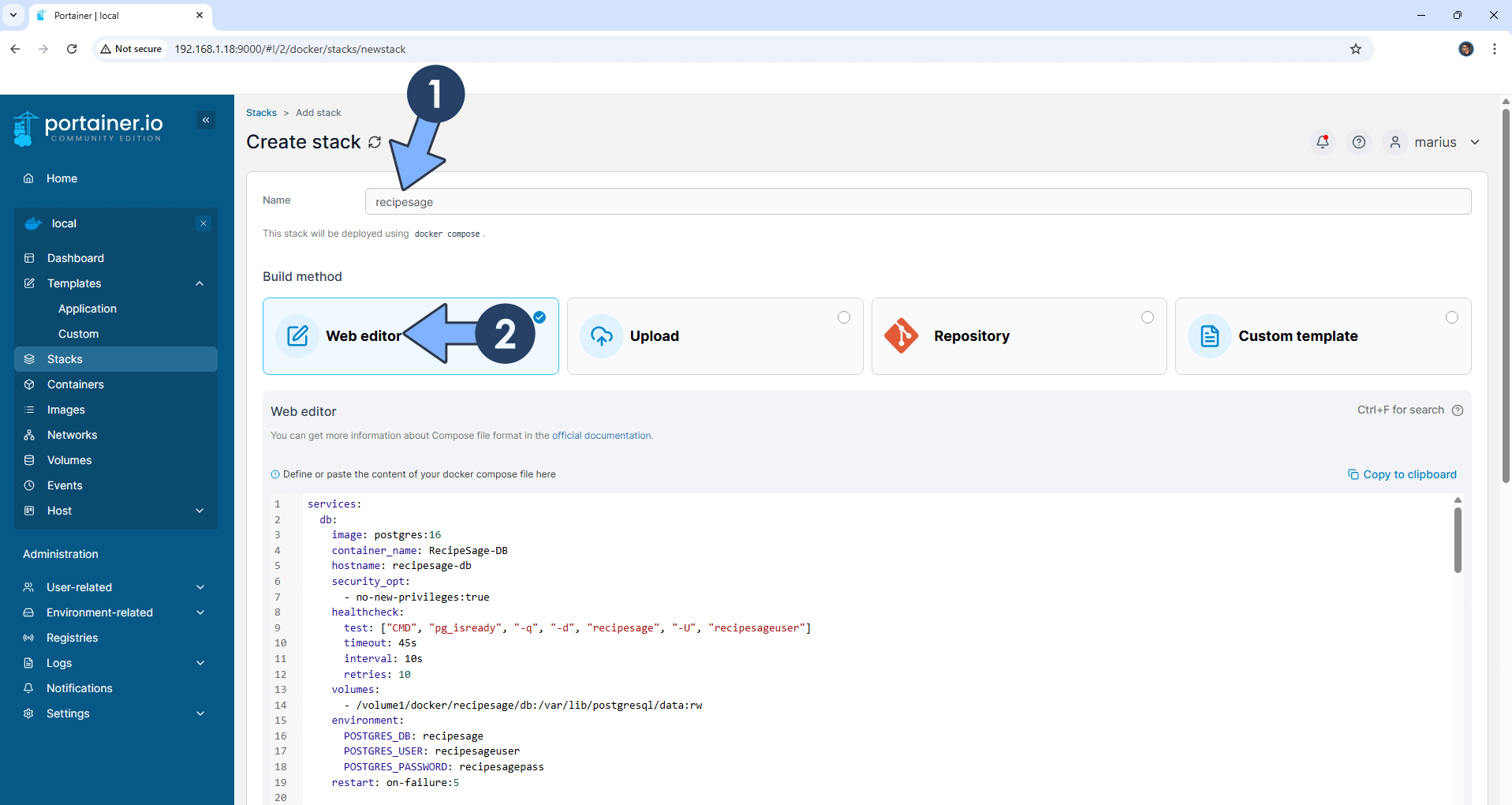
STEP 15
Scroll down on the page until you see a button named Deploy the stack. Click on it. Follow the instructions in the image below. The installation process can take up to a few minutes. It will depend on your Internet speed connection.
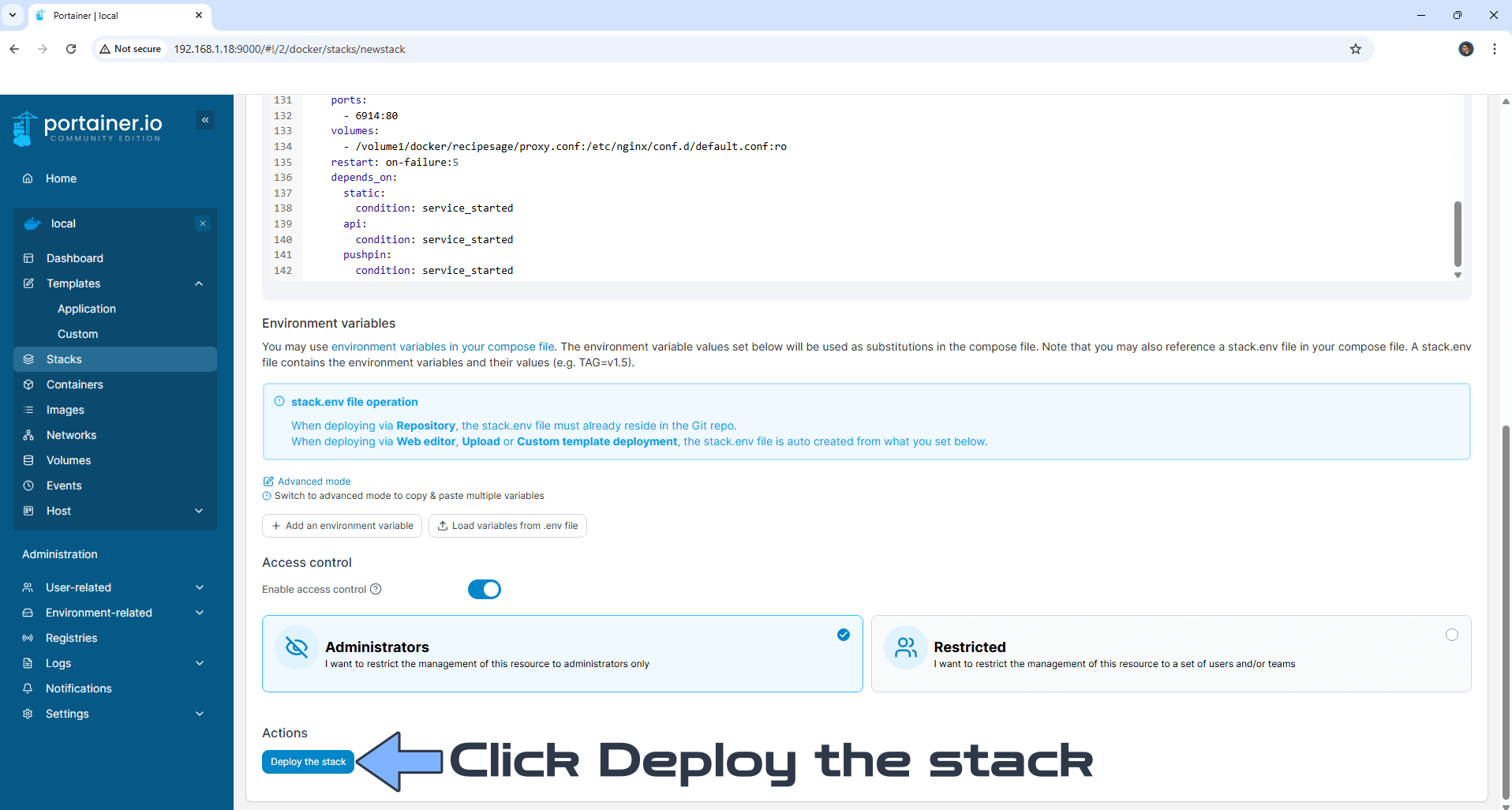
STEP 16
If everything goes right, you will see the following message at the top right of your screen: “Success Stack successfully deployed“.
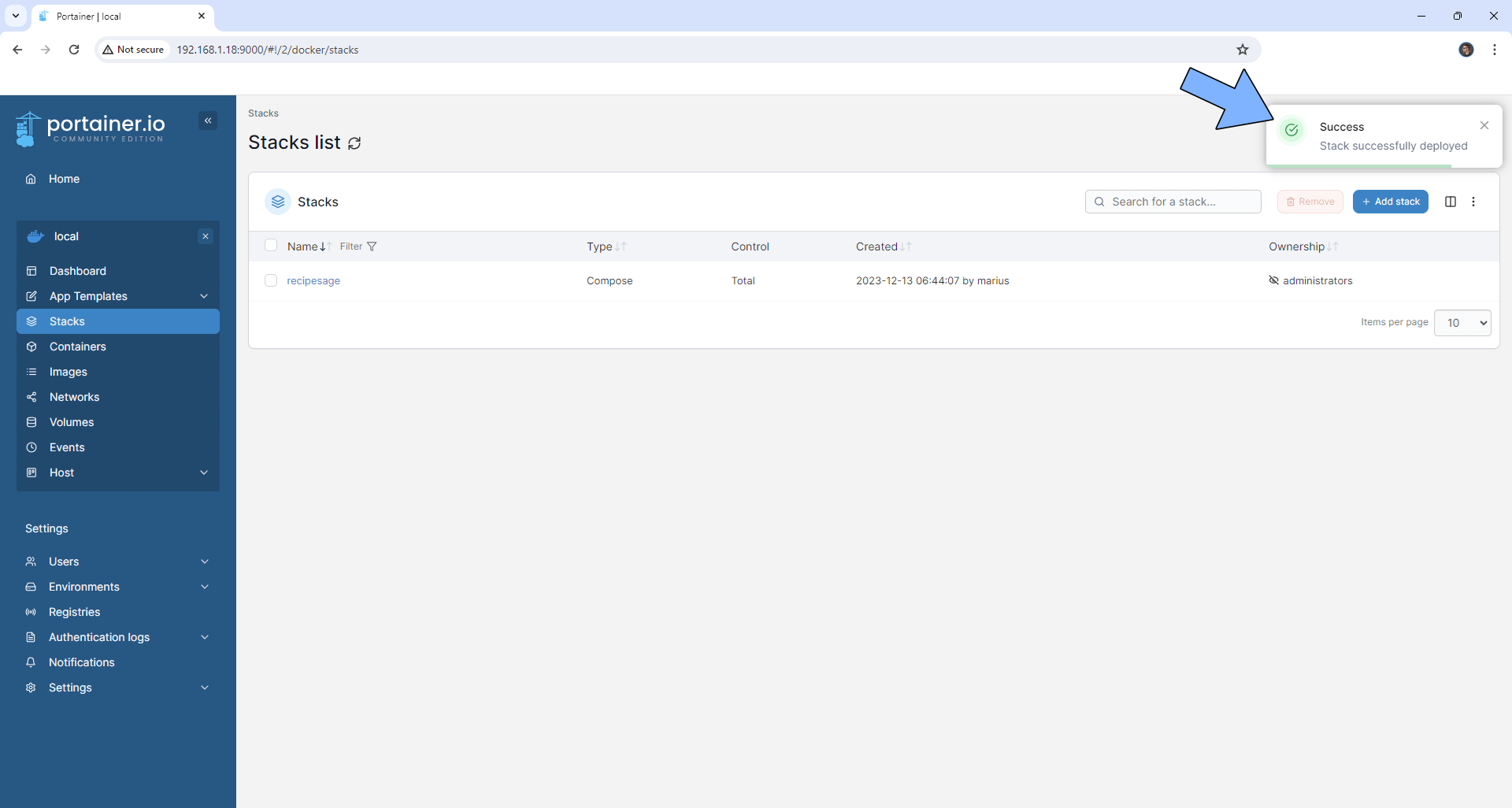
STEP 17
Please wait approximately 10 minutes or you will get a blank synology error page if you try to connect too soon. Now open your browser and type in your HTTPS/SSL certificate like this https://recipesage.yourname.synology.me that you have previously created at STEP 6. In my case it’s https://recipesage.mariushosting.synology.me If everything goes right, you will see the RecipeSage start page. Click CREATE AN ACCOUNT. Follow the instructions in the image below.
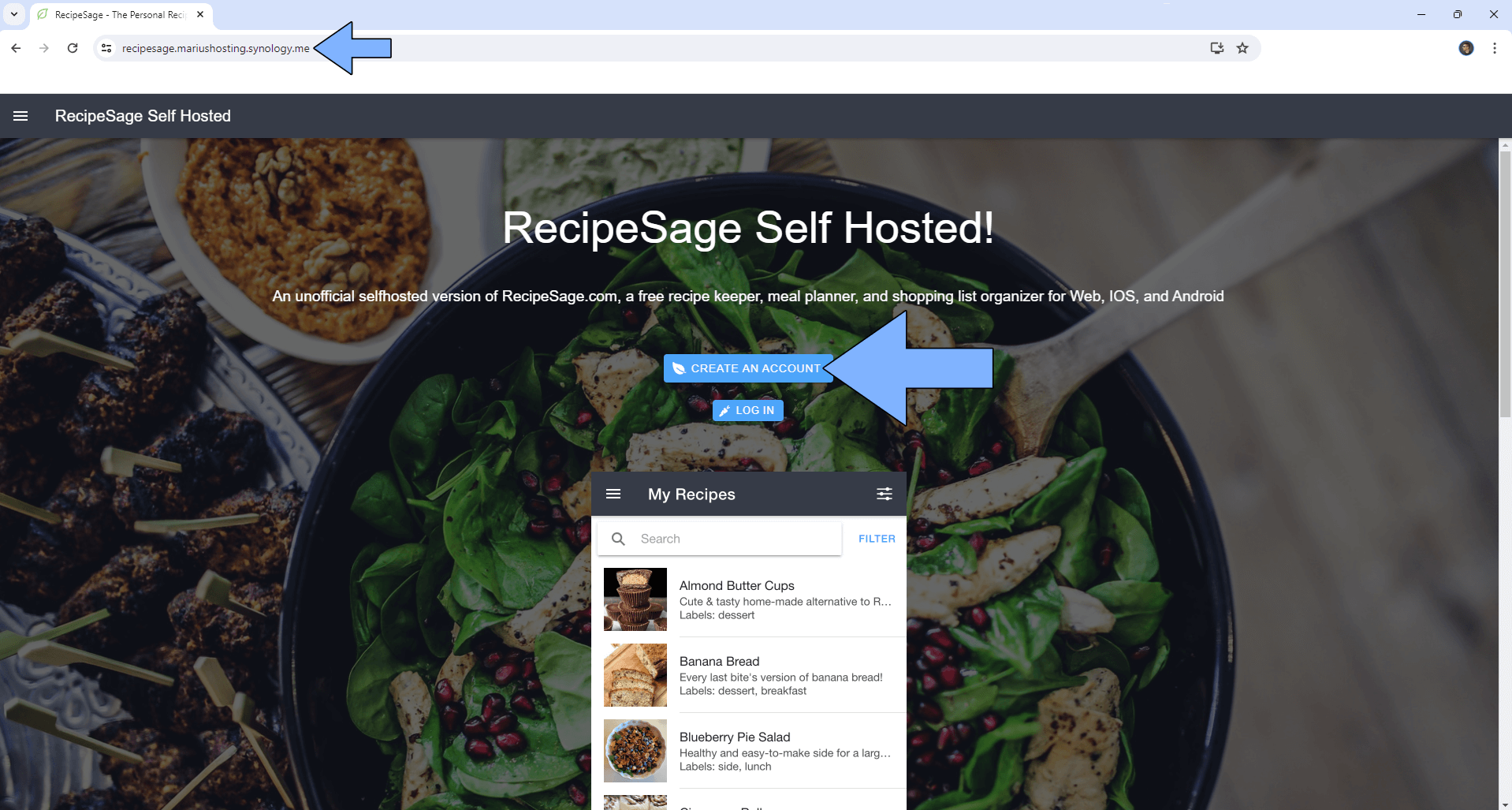
STEP 18
Type in your own details then click CREATE ACCOUNT. Follow the instructions in the image below.
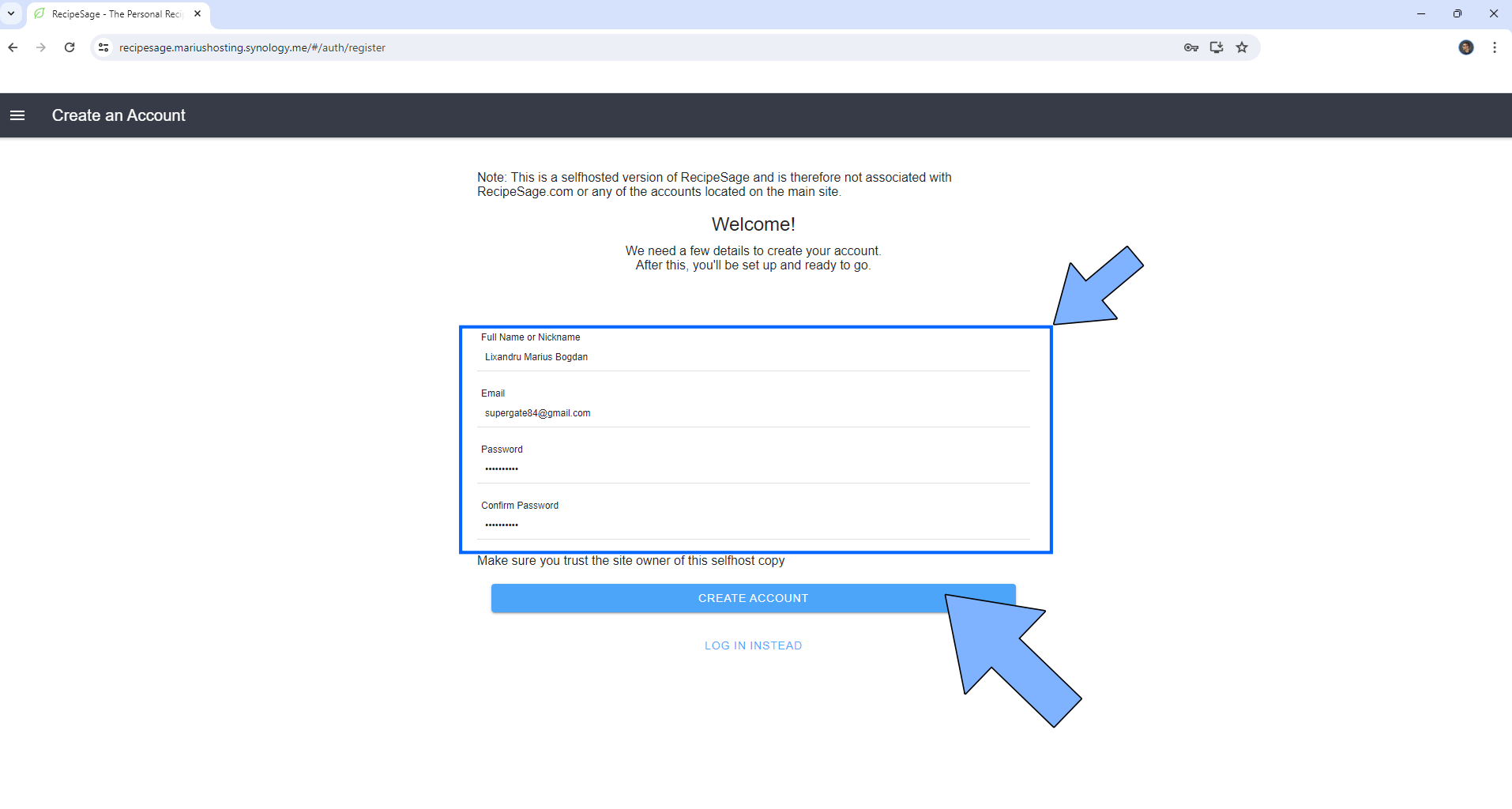
STEP 19
Your RecipeSage dashboard at a glance!
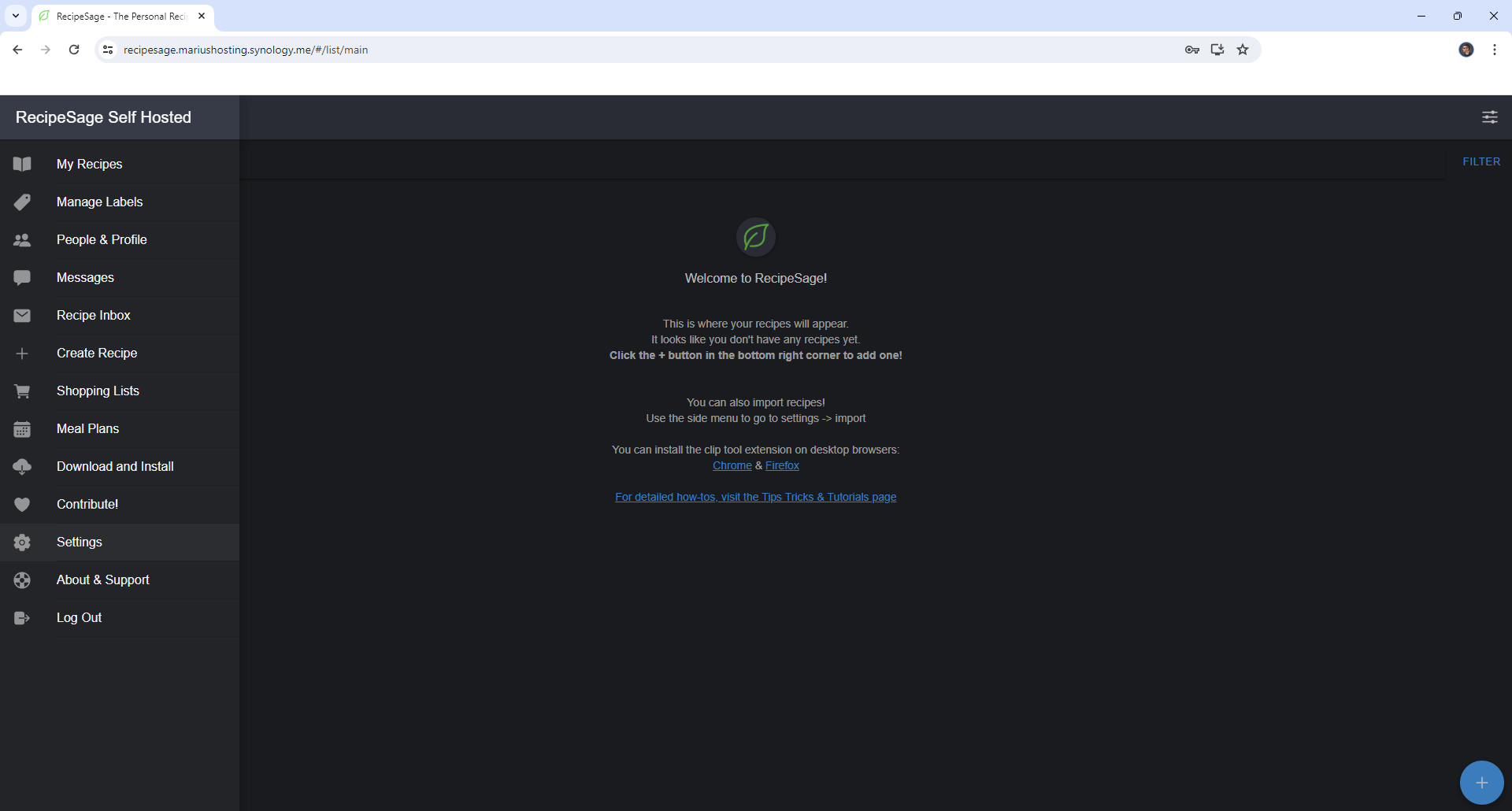
STEP 20
From now on, if you want to restrict user registration to your RecipeSage instance, just add in the compose at STEP 14 the following line under BROWSERLESS_PORT: 3000
DISABLE_REGISTRATION: trueEnjoy RecipeSage!
If you encounter issues by using this container, make sure to check out the Common Docker issues article.
Note: Can I run Docker on my Synology NAS? See the supported models.
Note: How to Back Up Docker Containers on your Synology NAS.
Note: Find out how to update the RecipeSage container with the latest image.
Note: How to Free Disk Space on Your NAS if You Run Docker.
Note: How to Schedule Start & Stop For Docker Containers.
Note: How to Activate Email Notifications.
Note: How to Add Access Control Profile on Your NAS.
Note: How to Change Docker Containers Restart Policy.
Note: How to Use Docker Containers With VPN.
Note: Convert Docker Run Into Docker Compose.
Note: How to Clean Docker.
Note: How to Clean Docker Automatically.
Note: Best Practices When Using Docker and DDNS.
Note: Some Docker Containers Need WebSocket.
Note: Find out the Best NAS Models For Docker.
Note: Activate Gmail SMTP For Docker Containers.
This post was updated on Monday / July 7th, 2025 at 11:41 PM
